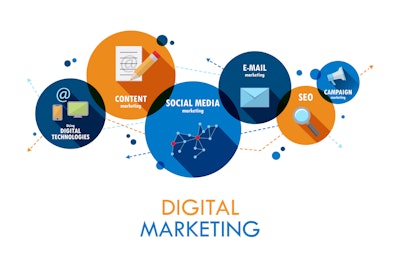
Being excellent at your trade is always critical to success, but what about excelling on the business side of things? The two don’t always go hand in hand and often present a challenge to those simply trying to do their job. Running a prosperous business in the landscaping industry requires a broad skillset, and savvy entrepreneurs know when to enlist expertise. You are the expert in landscaping, lawn care, even equipment, but how much do you know about digital marketing? ©treenabeena - stock.adobe.com
©treenabeena - stock.adobe.com
A key area of need in business planning should be customer acquisition. Every business needs customers, and yours is no exception. How do you find new customer leads and convince them to learn more about your business? How do you ensure you’re doing it in an environmentally friendly, sustainable, and affordable way? The following tips will show you how.
Impacting Customer Research Online
Start when a potential customer begins researching a product or service. A customer’s journey to a purchase decision is different today than even six months ago. More and more customers rely on online research to make purchase decisions, reducing the need for personal interaction. This change opens the door for local businesses to reach consumers anywhere by creating a comprehensive presence across multiple digital touchpoints.
According to recent data, about 93 percent of consumers research companies and products online before making a purchase. This means a business must bring its message to life at the local level. If the product is well presented to the right customers during their online research, the local retailer will stand out.
Budgets are tighter than ever, making it critical to get the most value from your spend to generate actual sales returns. A well-designed, comprehensive, and cohesive website that includes consistent, quality brand images, product information, and promotions is cost effective and ultimately results in sales. A microsite for a specific product can look like a full website with all the relevant information for customers to do their research. As one industry example, a Grasshopper mower can cost thousands of dollars, warranting pre-purchase research for the best value. Upon implementation of such a strategy, Grasshopper saw an increase in leads at both the brand and local levels: In the first year, they realized a tenfold increase in leads, and their online sales increased nearly 50 percent. Consumers had an overwhelmingly positive response to the presentation of quality information. The dealers who participated in the program were 55 times more likely to receive leads than those who didn’t use the platform. A comparable plan could work for any small business to promote its brands.
Local retailers are doing many things right when it comes to their online experiences but providing current and relevant information on behalf of the brands they represent is an area that often falls short. The information can range from seasonal promotions and updated pricing to the latest and greatest competitive advantages. Customers expect clear, reliable information when navigating a business’ online presence. A targeted, digital platform can send consistent messages across local websites to ensure they align with a national brand marketing campaign.
Reaching the Right Customers
A potential customer must first find you to begin a business inquiry. You can stand out by ensuring your business is easily found when your products or services match a customer's search through paid search advertising. Most consumers start the buying process by conducting an online search through tools such as Google; therefore, local businesses must run local paid search ads to capitalize on these highly qualified hand raises. People are actively looking to buy, so running local paid search ads places a business name, address, and phone number directly in front of those customers already expressing an interest in your product or service. Even in a trying climate, this isn’t the time to reduce your digital spend. It’s time to allocate your resources through better targeting more carefully.
An efficient digital program monitors its value by measuring the cost per lead (CPL), the cost per business site session and the percentage of new users in real-time. Traditional advertising generates awareness but doesn't always translate directly to sales leads for a local business. An overall branded digital campaign tailored for use by specific businesses ultimately drives customers to purchase at a lower cost per lead.
There isn’t a defined blueprint for success when it comes to brand-to-local online customer experiences and advertising. Still, there are essential best practices, including a well-defined and frictionless customer journey, advertising across many channels to meet customers in their moment of intent, and the ability to provide the desired information online quickly. It’s estimated that a brand must reach a customer seven times before earning a customer’s purchase. That sounds like a lot of contacts, but it doesn’t have to be overwhelming or cumbersome. A local business owner or advertiser must be agile and think through the required customer journey touchpoints, from awareness and research to purchase consideration, to succeed.  ©EtiAmmos - stock.adobe.com
©EtiAmmos - stock.adobe.com
Local digital marketing solutions include paid search advertising, local dealer retargeting, local rich media display, local social lead ads and more as part of scalable programs that allow retailers to bring brands to life in local ads. A local business can’t be afraid of technology tool adoption and scalable advertising endeavors to connect with customers in today’s complex online ecosystem.
Small businesses should consider adopting an advertising investment philosophy playing by the rule of 70-20-10. That means 70 percent of the budget goes to “tried and true” initiatives, the key marketing activities that have been proven to drive new business to a retail store; 20 percent of the budget allocates to “safe bet” activities, those that have a high probability of success; then, the remaining 10 percent is dedicated as an experimental budget to try new opportunities and see what sticks. This approach allows a retailer to be flexible and keep the business moving forward in today’s ever-evolving digital world.
 ©peshkov - stock.adobe.com
©peshkov - stock.adobe.com














![Gravely Pro Turn Mach One My23 Dsc03139 Edit 1200x800 5b2df79[1]](https://img.greenindustrypros.com/mindful/acbm/workspaces/default/uploads/2025/10/gravely-pro-turn-mach-one-my23-dsc03139-edit-1200x800-5b2df791.BucBnDoN22.jpg?ar=16%3A9&auto=format%2Ccompress&fit=crop&h=135&q=70&w=240)





